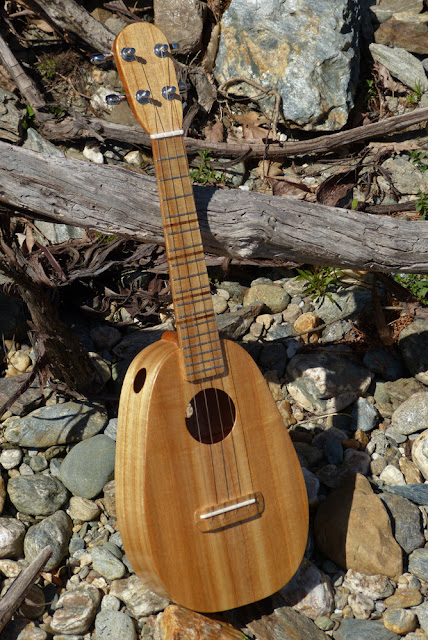2009 Makapili Acacia Pineapple Concert Ukulele
Makapili ukes are made by a fellow named Thomas Macomson who seems to move around a bit in terms of where his workshop hat resides. I'll tell you what, though: he can certainly make a good uke! In many ways his instruments (there are two in-shop right now) are more "island" than a number of newer "island" makes: they're feather-light, the wood is paper-thin, and the bracing is lightweight and peculiar. They're also a little "folksy" like a good old Kamaka and have details that aren't quite "perfect" but serve to keep the instrument "real" rather than feeling like it popped out of a CNC mill.
This one is a concert-size pineapple-shaped instrument with a 14-fret neck joint, 15" scale length, and a solid acacia body (and freboard). The neck is Spanish cedar and there's contrasting wooden inlay for fretmarkers. Both the nut and saddle appear to be some sort of dense, hard plastic as they didn't smell like bone when I was working them.
The uke came into the shop in more-or-less good order, though for whatever reason the frets were all helter-skelter in relation to one another with an overall hair of warp and "ski jump" to the neck. All that was ruled-out in a fret level/dress which got their tops all along the same plane, though some are lower than others (you will not notice this unless you look for it). They dressed-up nicely and after setup action is spot-on at 1/16" at the 12th fret, strung with fluorocarbons.
There's light use-wear on the uke -- one scratch on the back and one on the lower bout and a bit of pickwear around the soundhole. Overall, though, it's in gorgeous shape and the uke presents itself beautifully.
Tonally, this thing is absurdly loud and powerful and has a voice that carries with authority. If you want to fill space and keep your sweet tone at the same time -- look no further. In many ways this is in the same realm as a nice Kamaka concert, though with a little less sparkle to the high register and a little more velvet on the bottom.
While the sealed Grover tuners are a little heavy, they work well. One side of the headstock has the tuners ever so slightly closer to the edge than the other.
Aren't those inlays lovely?
Soundport! This is quite a nice modern feature -- it's often hard to hear exactly what you're doing in a jam, isn't it?
Makapili ukes seem to mostly use string-through bridges -- a system I like. You pass the string through, pull it out the soundhole, knot it a number of times into a "ball-end," and then pull it up tight against the bridge plate inside. It's a very secure mounting method and relieves the bridge of much sideways tension that would otherwise be pulling it off.
Here you can see some of the lovely grain on the top.
The neck is a Spanish heel design -- meaning the neck block and neck are one and the same. This is "typical Hawaiian style" for older island ukes and it's very, very sturdy while allowing for a smallish heel that's elegant and frees up more fretting area.
The soundport lets us take a look at his intriguing scalloped, modified fan bracing. His main "below the soundhole" ladder brace is set at an angle -- something the best-sounding fan-braced classical guitars (in my opinion) do as well. It frees-up the bass a lot more.



















Comments